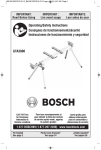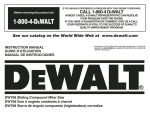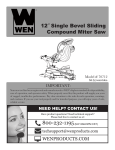Download DeWalt DW708 Instruction manual
Transcript
® DW708 14 15 16 1 2 13 3 11A 4 12 11 10 5 9 6 8 7 A1 18 17 19 26 20 21 25 22 23 24 A2 16 28 10 B 27 C 29 31 30 2 33 7 32 33 D1 37 36 38 34 35 E 26 6 D2 F 40 39 34 5 4 37 4 42 36 41 G H1 11 20 11 43 44 43A 12 45 H3 H2 7 11A 46 23 11 H4 J 19 20 K L 1 47 20 4 5 M2 M1 23 11 49 3 N1 7 M3 N2 A N3 N4 6 O P1 21 P2 22 R Q1 Q2 ENGLISH Safety instructions When using Power Tools, always observe the safety regulations applicable in your country to reduce the risk of fire, electric shock and personal injury. Read the following safety instructions before attempting to operate this product. Keep these instructions in a safe place! General 1 Keep work area clean Cluttered areas and benches can cause accidents. 2 Consider work area environment Do not expose Power Tools to humidity. Keep work area well lit. Do not use Power Tools in the presence of inflammable liquids or gases. 3 Guard against electric shock Prevent body contact with earthed surfaces (e.g. pipes, radiators, cookers and refrigerators). For use under extreme conditions (e.g. high humidity, when metal swarf is being produced, etc.) electric safety can be improved by inserting an isolating transformer or a (FI) earth-leakage circuit-breaker. 4 Keep children away Do not let children come into contact with the tool or extension cord. Supervision is required for those under 16 years of age. 5 Extension cords for outdoor use When the tool is used outdoors, always use extension cords intended for outdoor use and marked accordingly. 6 Store idle tools When not in use, Power Tools must be stored in a dry place and locked up securely, out of reach of children. 7 Dress properly Do not wear loose clothing or jewellery. They can be caught in moving parts. Preferably wear rubber gloves and non-slip footwear when working outdoors. Wear protective hair covering to keep long hair out of the way. 8 Wear safety goggles Also use a face or dust mask in case the operations produce dust or flying particles. 9 Beware of maximum sound pressure Take appropriate measures for the protection of hearing if the sound pressure of 85 dB(A) is exceeded. 10 Secure workpiece Use clamps or a vice to hold the workpiece. It is safer and it frees both hands to operate the tool. 11 Do not overreach Keep proper footing and balance at all times. 12 Avoid unintentional starting Do not carry the plugged-in tool with a finger on the switch. Be sure that the switch is released when plugging in. 13 Stay alert Watch what you are doing. Use common sense. Do not operate the tool when you are tired. 14 Disconnect tool Shut off power and wait for the tool to come to a complete standstill before leaving it unattended. Unplug the tool when not in use, before servicing or changing accessories. 15 Remove adjusting keys and wrenches Always check that adjusting keys and wrenches are removed from the tool before operating the tool. 16 Use appropriate tool The intended use is laid down in this instruction manual. Do not force small tools or attachments to do the job of a heavy-duty tool. The tool will do the job better and safer at the rate for which it was intended. Warning! The use of any accessory or attachment or performance of any operation with this tool, other than those recommended in this instruction manual may present a risk of personal injury. 18 17 Do not abuse cord Never carry the tool by its cord or pull it to disconnect from the socket. Keep the cord away from heat, oil and sharp edges. 18 Maintain tools with care Keep the tools in good condition and clean for better and safer performance. Follow the instructions for maintenance and changing accessories. Inspect the tool cords at regular intervals and, if damaged, have them repaired by an authorized DEWALT repair agent. Inspect the extension cords periodically and replace them if damaged. Keep all controls dry, clean and free from oil and grease. 19 Check for damaged parts Before using the tool, carefully check it for damage to ensure that it will operate properly and perform its intended function. Check for misalignment and seizure of moving parts, breakage of parts and any other conditions that may affect its operation. Have damaged guards or other defective parts repaired or replaced as instructed. Do not use the tool if the switch is defective. Have the switch replaced by an authorized DEWALT repair agent. 20 Have your tool repaired by an authorized DEWALT repair agent This Power Tool is in accordance with the relevant safety regulations. To avoid danger, electric appliances must only be repaired by qualified technicians. Additional safety rules for mitre saws • Make sure that the blade rotates in the correct direction. Keep the blade sharp. Do not use blades of larger or smaller diameter than recommended. For the proper blade rating refer to the technical data. • Make sure all locking knobs and clamp handles are tight before starting any operation. • Check periodically that the motor air slots are clean and free of chips. • Disconnect the machine from the mains before carrying out any maintenance work or when changing the blade. • Before using any accessory consult the instruction manual. The improper use of an accessory can cause damage. • Allow the motor to reach full speed before cutting. • Raise the blade from the kerf in the workpiece prior to releasing the switch. • Do not wedge anything against the fan to hold the motor shaft. • Never place either hand in the blade area when the saw is connected to the electrical power source. • Do not attempt to cut excessively small pieces. • Never attempt to stop a machine in motion rapidly by jamming a tool or other means against the blade; serious accidents can be caused unintentionally in this way. • Do not use cracked or damaged saw blades. • Do not use any abrasive discs. • Do not cut ferrous metals, non-ferrous metals or masonry. • Never use your saw without the kerf plate. • The blade guard on your saw will automatically raise when the arm is brought down; it will lower over the blade when the arm is raised. The guard can be raised by hand when installing or removing saw blades or for inspection of the saw. Never raise the blade guard manually unless the saw is turned OFF. • The front section of the guard is louvred for visibility while cutting. Although the louvres dramatically reduce flying debris, there are openings in the guard and safety glasses should be worn at all times when viewing through the louvres. en - 2 ENGLISH Residual risks The following risks are inherent to the use of mitre saws: - injuries caused by touching the rotating parts In spite of the application of the relevant safety regulations and the implementation of safety devices, certain residual risks cannot be avoided. These are: - Impairment of hearing. - Risk of accidents caused by the uncovered parts of the rotating saw blade. - Risk of injury when changing the blade. - Risk of squeezing fingers when opening the guards. - Health hazards caused by breathing dust developed when sawing wood, especially oak, beech and MDF. Electrical safety Conductor size (mm2) Cable rating (Amperes) 0.75 1.00 1.50 2.50 4.00 6 10 15 20 25 Voltage 115 230 The electric motor has been designed for one voltage only. Always check that the power supply corresponds to the voltage on the rating plate. Your DEWALT tool is double insulated in accordance with EN 50144; therefore no earth wire is required. Mains plug replacement (U.K. & Ireland only) • Should your mains plug need replacing and you are competent to do this, proceed as instructed below. If you are in doubt, contact an authorized DEWALT repair agent or a qualified electrician. • Disconnect the plug from the supply. • Cut off the plug and dispose of it safely; a plug with bared copper conductors is dangerous if engaged in a live socket outlet. • Only fit 13 Amperes BS1363A approved plugs fitted with the correctly rated fuse (1). • The cable wire colours, or a letter, will be marked at the connection points of most good quality plugs. Attach the wires to their respective points in the plug (see below). Brown is for Live (L) (2) and Blue is for Neutral (N) (4). • Before replacing the top cover of the mains plug ensure that the cable restraint (3) is holding the outer sheath of the cable firmly and that the two leads are correctly fixed at the terminal screws. Amperes 0 - 2.0 2.1 - 3.4 3.5 - 5.0 5.1 - 7.0 7.1 - 12.0 12.1 - 20.0 0 - 2.0 2.1 - 3.4 3.5 - 5.0 5.1 - 7.0 7.1 - 12.0 12.1 - 20.0 Cable length (m) 7.5 15 25 30 Cable rating (Amperes) 6 6 6 6 6 6 6 6 6 6 10 15 10 10 15 20 15 15 20 25 20 20 25 6 6 6 6 6 6 6 6 6 6 6 6 10 10 10 10 15 15 15 15 20 20 20 20 45 60 6 15 20 20 25 6 6 10 15 20 25 10 15 20 25 6 6 15 15 20 - Unpacking (fig. A1, A2 & B) Remove the saw from the packing material carefully using the carrying handle (9) and the rails (14). The package contains: 1 Assembled sliding compound mitre saw 1 Saw blade wrench 1 60 teeth 305 mm TCT saw blade 1 Stabilizer 1 Instruction manual 1 Exploded drawing • Check for damage to the tool, parts or accessories which may have occurred during transport. • Take the time to thoroughly read and understand this manual prior to operation. • Press down the operating handle (17) and pull out the lock down pin (16), as shown in fig. B. • Gently release the downward pressure and allow the arm to rise to its full height. Description (fig. A1 & A2) Your DW708 sliding compound mitre saw has been designed for professional cutting of wood, wood products, aluminium and plastics. It will perform the sawing operations of cross-cutting, bevelling and mitring easily, accurately and safely. A1 Never use a light socket. Never connect the live (L) or neutral (N) wires to the earth pin marked E or . For 115 V units with a power rating exceeding 1500 W, we recommend to fit a plug to BS4343 standard. Using an extension cable If an extension cable is required, use an approved extension cable suitable for the power input of this tool (see technical data). The minimum conductor size is 1.5 mm2. When using a cable reel, always unwind the cable completely. Also refer to the table below. en - 3 1 2 3 4 5 6 7 8 9 10 11 11A 12 13 14 15 16 ON/OFF-switch Lower blade guard Fence, right-hand side Mitre lever Mitre latch Mitre scale Fence, left-hand side Bench mounting holes Base Base stabiliser Bevel lever Bevel stop override button Bevel stop screw Saw blade wrench Rails Dust extraction adapter Lock down pin 19 ENGLISH A2 17 18 19 20 21 22 23 24 25 26 Operating handle Carrying handle Rail adjustment screws Rail lock knob Thumbscrew Grooving stop Fence adjustment knob Handhold Kerf plate Spindle lock button To use the spindle lock, press the button as shown and rotate the spindle by hand until you feel the lock engage. Continue to hold the lock button in to keep the spindle from turning (fig. D2). • Remove the blade screw (31) and the outer flange (32) (fig. D1). • Install the saw blade (33) onto the inner flange making sure that the teeth at the bottom edge of the blade are pointing toward the back of the saw (away from the operator). • Replace the outer flange (32). • Tighten the blade locking screw (31) by turning counter-clockwise while holding the lower guard up and the spindle lock engaged with your other hand. Assembly Never press the spindle lock while the blade is rotating. Prior to assembly always unplug the tool. Adjustment The motor and guards are already assembled onto the base. Stabilizer (fig. C) Your saw includes one base stabilizer (10). • Insert the stabilizer into the holes (27). • Move the stabilizer in or out until it contacts the work surface. • Tighten the screws (28). Never use your saw without the stabilizer. Bench mounting (fig. A2) • Holes (8) are provided in all four feet to facilitate bench mounting. Two different sized holes are provided to accommodate different sizes of bolts. Use either hole; it is not necessary to use both. Always mount your saw firmly to prevent movement. To enhance the portability, the tool can be mounted to a piece of 12.5 mm or thicker plywood which can then be clamped to your work support or moved to other job sites and reclamped. • When mounting your saw to a piece of plywood, make sure that the mounting screws do not protrude from the bottom of the wood. The plywood must sit flush on the work support. When clamping the saw to any work surface, clamp only on the clamping bosses where the mounting screw holes are located. Clamping at any other point will interfere with the proper operation of the saw. • To prevent binding and inaccuracy, be sure the mounting surface is not warped or otherwise uneven. If the saw rocks on the surface, place a thin piece of material under one saw foot until the saw is firm on the mounting surface. Mounting the saw blade (fig. A1, A2, D1 & D2) The teeth of a new blade are very sharp and can be dangerous. Lock the mitre lever (4), the rail lock knob (20) and the bevel lever (11) (fig. A1 & A2). • Depress the head lock up release lever (50) to release the lower guard (2), then raise the lower guard as far as possible. • Loosen the upper guard cover screw (29) and pivot the upper guard (30) up. Never replace the screw (29) with a different screw! • Hold the guard up, press the spindle lock button (26) (fig. D2) and loosen the blade screw (31) by turning clockwise using the saw blade wrench (fig. D1). 20 Prior to adjustment always unplug the tool. Your mitre saw was accurately adjusted at the factory. If readjustment due to shipping and handling or any other reason is required, follow the steps below to adjust your saw. Once made, these adjustments should remain accurate. Checking and adjusting the blade to the fence (fig. E) • Loosen the mitre lever (4) and squeeze the mitre latch (5) upwards to release the scale/mitre arm assembly (34). • Swing the mitre arm until the latch locates it at the 0° mitre position. Do not tighten the lever (4). • Pull down the head until the blade just enters the saw kerf (35). • Place a square (36) against the lower part (37) of the fence (7) and blade (33). Do not touch the tips of the blade teeth with the square. If adjustment is required, proceed as follows: • Loosen the four screws (38) and move the scale/mitre arm assembly (34) left or right until the blade is at 90° to the fence as measured with the square. • Retighten the four screws (38). Pay no attention to the reading of the mitre pointer at this point. Adjusting the mitre pointer (fig. F) • Loosen the mitre lever and squeeze the mitre latch to release the scale/mitre arm assembly (34). • Move the saw arm to set the mitre pointer (39) to the zero position. • With the mitre clamp knob loose, allow the mitre latch to snap into place as you rotate the mitre arm past zero. • Observe the pointer (39) and mitre scale (6). If the pointer does not indicate exactly zero, loosen the screw (40) and gently move the pointer left or right. • Retighten the screw (40). Mitre lock/detent rod adjustment (fig. G) If the base of the saw can be moved while the mitre lever (4) is locked, the mitre lock/detent rod (41) should be adjusted. • Unlock the mitre lever (4). • Fully tighten the mitre lock/detent rod (41) by turning it clockwise using a screwdriver (42). Turn counterclockwise 1/4 of a turn. • Check that the table will not rotate when the lever (4) is locked at a random (not preset) angle. en - 4 ENGLISH Bevel stop adjustment (fig. H1 - H4) Adjusting the bevel stop and pointer to 0° (fig. H1 & H2) • Place the saw in the 0° bevel position (fig. H1). • Push the head fully back and tighten the rail lock knob (20) (fig. H2). • Place a set square (36) on the table and up against the blade (33) (fig. H1). Do not touch the tips of the blade teeth with the square. If adjustment is required, proceed as follows: • Loosen the bevel lever (11) (fig. H2). • Press the mitre arm to the right, against the 0° bevel stop. • Adjust the screw (43) until the blade is perpendicular to the base. • Tighten the lever (11) securely. • Make sure the bevel pointer (44) indicates exactly 0°. • If not, loosen the screw (45), set the pointer to 0° and tighten the screw. Adjusting the bevel stop to 45° left or right (fig. H2 - H4) First, adjust the 0° bevel angle. - Left 45° bevel angle • Loosen the bevel lever (11) and tilt the head to the left (fig. H3). • If the pointer (44) does not indicate exactly 45°, turn the screw (12) on the left side until the pointer reads 45° (fig. H2). - Right 45° bevel angle • Depress the bevel stop override button (11A) and tilt the head to the right (fig. H4). • If the pointer does not indicate exactly 45°, turn the screw (43A) on the lower right side until the pointer reads 45° (fig. H3). Adjusting the fence (fig. A1 & J) The fences (3) and (7) can be adjusted to provide clearance, allowing the saw to bevel to a full 48°. • Loosen the fence adjustment knob (23) and slide the fence to the required position (fig. J). • Make a dry run with the saw turned OFF and check for clearance. Adjust the fence to be as close to the blade as practical to provide maximum workpiece support, without interfering with the up and down movement of the arm. • Firmly tighten the fence adjustment knob (23). • Move the fences back after the cut has been accomplished. When bevelling to the right, it may be necessary to remove the right fence (3) (fig. A1) Rail guide adjustment (fig. K) • Regularly check the rails for clearance. • To reduce clearance, gradually rotate the set screws (19) clockwise while sliding the saw head back and forth. Instructions for use Always observe the safety instructions and applicable regulations. The attention of UK users is drawn to the “woodworking machines regulations 1974” and any subsequent amendments. Prior to operation: • Make sure the guards have been mounted correctly. The saw blade guard must be in closed position. • Make sure the saw blade rotates in the direction of the arrow on the blade. • To stop the tool, release the switch. • There is no provision for locking the switch ON, but a hole (47) is provided for insertion of a padlock to lock the saw OFF. Basic saw cuts (fig. A1, A2, M1 - M3) Vertical straight cross cut (fig. A1 & A2) • Loosen the mitre lever (4) and squeeze the mitre latch (5) upwards. • Engage the mitre latch at the 0° position and tighten the lever (4). • Place the wood to be cut against the fences (3) and (7). • Take hold of the operating handle and depress the head lock up release lever (50) to release the head. • With the rail lock knob tightened, switch the saw ON. • Lower the head to allow the blade to cut through the workpiece and enter the kerf plate (25). • After completing the cut, release the switch, let the blade come to a full stop and return the head to its upper rest position. Workpieces larger than 50 x 100 mm (fig. M1) The guide rail allows cutting larger workpieces using an out-down-back motion. • Release the rail lock knob (20). • Pull the saw towards you, lower the saw into the workpiece and push it back to complete the cut. • Proceed as described above. Vertical mitre cross-cut (fig. M2) • Loosen the fence clamping knobs and adjust the fences. • Loosen the mitre lever (4) and squeeze the mitre latch (5) upwards. Move the head left or right to the required angle. • Always ensure that the lever (4) is locked tightly before cutting. • Proceed as for a vertical straight cross-cut. Bevel cuts (fig. M3, H2 & H4) • Loosen the fence clamping knobs (23) and adjust the fences (3) and (7). Loosen the bevel lever (11) and set the required angle. • Tighten the lever (11) firmly. • To bevel to the right, depress the bevel stop override button (11A). Bevelling 48° to the left (fig. H2 & H3) To set a bevel angle greater than 45°, the bevel stop must be adjusted. • Loosen the bevel lever (11) and tilt the head to the left. • Turn the screw (12) until the pointer (44) indicates the desired bevel angle (up to 48°). Bevelling 48° to the right (fig. H2 - H4) To set a bevel angle greater than 45°, the bevel stop must be adjusted. • Depress the bevel stop override button (11A) and tilt the head to the right. • Turn the screw (43A) until the pointer (44) indicates the desired bevel angle (up to 48°). Quality of cut The smoothness of any cut depends on a number of variables, e.g. the material being cut. When smoothest cuts are desired for moulding and other precision work, a sharp (60 tooth carbide) blade and a slower, even cutting rate will produce the desired results. Ensure that the material does not creep while cutting; clamp it securely in place. Always let the blade come to a full stop before raising the arm. If small fibres of wood still split out at the rear of the workpiece, stick a piece of masking tape on the wood where the cut will be made. Saw through the tape and carefully remove tape when finished. Switching ON and OFF (fig. L) • To run the tool, press the ON/OFF-switch (1). en - 5 21 ENGLISH If the cutting angle varies from cut to cut, check that the bevel and mitre levers are securely tightened. • The chart shown below will assist you in selecting the proper bevel and mitre settings for common compound mitre cuts. To use the chart, select the desired angle “A” (fig. N4) of your project and locate that angle on the appropriate arc in the chart. From that point follow the chart straight down to find the correct bevel angle and straight across to find the correct mitre angle. • Set your saw to the prescribed angles and make a few trial cuts. • Practice fitting the cut pieces together. • Example: To make a 4 sided box with 25° exterior angles (angle “A”) (fig. N4), use the upper right arc. Find 25° on the arc scale. Follow the horizontal intersecting line to either side to get the mitre angle setting on the saw (23°). Likewise follow the vertical intersecting line to the top or bottom to get the bevel angle setting on the saw (40°). Always try cuts on a few scrap pieces of wood to verify the settings on the saw. 0 5 10 80 85 45 15 25 30 35 40 45 SQUARE BOX 65 40 Trim moulding and other frames Try a few simple projects using scrap wood until you develop a “feel” for your saw. Your saw is the perfect tool for mitring corners like the one shown in fig. N1. The joint shown has been made using either bevel adjustment. 50 45 40 6 SIDED BOX 75 65 30 Using mitre adjustment The same cut can be made by mitring right and left with the broad surface against the fence. The two sketches (fig. N1 & N2) are for four side objects only. As the number of sides changes, so do the mitre and bevel angles. The chart below gives the proper angles for a variety of shapes, assuming that all sides are of equal length. For a shape that is not shown in the chart, divide 180° by the number of sides to determine the mitre or bevel angle. No. of sides 4 5 6 7 8 9 10 22 Angle mitre or bevel 45° 36° 30° 25.7° 22.5° 20° 18° 25 50 25 45 20 20 40 55 60 70 75 20 80 85 55 60 25 35 50 45 15 15 30 40 15 25 35 30 10 8 SIDED BOX 10 15 20 15 5 10 20 25 10 5 5 10 5 5 Using bevel adjustment The bevel for the two boards is adjusted to 45° each, producing a 90° corner. The mitre arm is locked in the zero position. The wood is positioned with the broad flat side against the table and the narrow edge against the fence. 30 35 70 80 85 30 65 Cutting picture frames, shadow boxes & other four sided projects (fig. N1 - N4) 35 35 ANGLE OF SIDE OF BOX (ANGLE"A") Support for long workpieces • Always support long workpieces. • For best results, use the extension work support (DE7080) to extend the table width of your saw (available from your dealer as an option). Support long workpieces using any convenient means such as sawhorses or similar devices to keep the ends from dropping. SET THIS MITER ANGLE ON SAW 55 60 40 Always use a clamp when cutting small workpieces. 20 70 Clamping the workpiece (fig. M3) Always use a material clamp when cutting non-ferrous metals. • Whenever possible, clamp the workpiece to the saw. • For best results use the clamp (49) (DE7082) made for use with your saw (available from your dealer as an option). Clamp the workpiece to the fence. You can clamp to either side of the saw blade; remember to position your clamp against a solid, flat surface of the fence. Compound mitre (fig. N3 & N4) A compound mitre is a cut made using a mitre angle and a bevel angle at the same time. This is the type of cut used to make frames or boxes with slanting sides like the one shown in fig. N3. 75 Body and hand position Proper positioning of your body and hands when operating the mitre saw will make cutting easier, more accurate and safer. • Never place your hands near the cutting area. • Place your hands no closer than 150 mm from the blade. • Hold the workpiece tightly to the table and the fence when cutting. Keep your hands in position until the switch has been released and the blade has completely stopped. • Always make dry runs (without power) before finish cuts so that you can check the path of the blade. • Do not cross your hands. • Keep both feet firmly on the floor and maintain proper balance. • As you move the saw arm left and right, follow it and stand slightly to the side of the saw blade. • Sight through the guard louvres when following a pencil line. 0 5 10 15 20 25 30 35 40 45 SET THIS BEVEL ANGLE ON SAW Dual range mitre scale (fig. O) The mitre scale has two ranges of numbers for convenience, as shown in fig. O. One scale indicates 0° when the blade is square to the fence. At this position the other scale reads 90°. The 0° scale (larger numbers closer to the front edge) is used when calculating angles. To calculate the proper mitre angle, divide 180° by the number of sides of the box or frame. Refer to the previous chart for some examples. The 90° scale (smaller numbers behind the 0° scale) is used when a corner of your box or frame is measured with a protractor. For example, if you measure the corner of an 8 sided box, the protractor will read 135°. To determine the proper mitre setting, divide the measured angle by two. The proper mitre setting in this example is 671/2. Set this angle on the 90° scale. Vernier scale (fig. P1 - P3) Your saw is equipped with a vernier scale for added precision. For settings that require partial degrees (1/4°, 1/2°, 3/4°), the vernier scale allows you to accurately set mitre angles to the nearest 1/2° (15 minutes). To use the vernier scale follow the steps listed below. As an example, assume that the angle you want to mitre is 241/2° right. • Turn OFF the mitre saw. en - 6 ENGLISH • Set the mitre angle to the nearest whole degree desired by aligning the centre mark in the vernier scale, shown in (fig. P1), with the whole degree number etched in the mitre scale. Examine (fig. P1) closely; the setting shown is 24° right mitre. • To set the additional 1/2°, squeeze the mitre arm lock and carefully move the arm to the right until the 1/2° vernier mark aligns with the closest degree mark on the mitre scale. In this example, the closest degree mark on the mitre scale happens to be 25°. Fig. P2 shows a setting of 241/2° right mitre. When mitring to the right: - increase the mitre angle by moving the arm to align the appropriate vernier mark with the closest mark on the mitre scale to the right. - decrease the mitre angle by moving the arm to align the appropriate vernier mark with the closest mark on the mitre scale to the left. When mitring to the left: - increase the mitre angle by moving the arm to align the appropriate vernier mark with the closest mark on the mitre scale to the left. - decrease the mitre angle by moving the arm to align the appropriate vernier mark with the closest mark on the mitre scale to the right. Cutting base mouldings (fig. Q1 - Q4) Vertical position • Always make a dry run without power before making any cuts. Outside corner - Left side • Position the moulding with the bottom of the moulding against the fence. • Save the right side of the cut. - Right side • Position the moulding with top of the moulding against the fence. • Save the right side of the cut. Grooving (fig. R) Your saw is equipped with a grooving stop (22) and thumbscrew (21) to allow for groove cutting. • Flip the grooving stop (22) towards the front of the saw. • Adjust the thumbscrew (21) to set the depth of the groove cut. Cutting non-ferrous metals When cutting non-ferrous metals, the machine is only to be used to perform vertical straight and mitre cross-cuts in the mitre saw mode. We recommend that bevel and compound mitre cuts should not be performed in non-ferrous metals. The machine is not to be used for cutting ferrous metals. • Always use a material clamp when cutting non-ferrous metals. Make sure that the workpiece is clamped securely. • Only apply saw blades that are qualified for cutting non-ferrous metals. • When using lubricants, only apply wax or separation spray. Do not use emulsions or similar fluids. • Connect an FI or DI switch between machine and mains to avoid residual risks caused by metal swarf. Straight 90° cuts (fig. Q1) • Position the wood against the fence as shown in fig. Q1. • Turn the saw ON, allow the blade to reach full speed and lower the arm smoothly through the cut. The FI switch should comply with the following specifications: 45° mitre cuts (fig. Q2) • Position the moulding as shown in fig. Q2. • All cuts are made with the back of the moulding against the fence and the bottom of the moulding against the base. rated voltage rated current reaction time fusing current Inside corner - Left side • Mitre left 45°. • Save the left side of the cut. - Right side • Mitre right 45°. • Save the right side of the cut. The DI switch should comply with the following specifications: Outside corner - Left side • Mitre right 45°. • Save the left side of the cut. - Right side • Mitre left 45°. • Save the right side of the cut. DIN VDE 0661 rated voltage rated current fusing current all-pole cutoff PE monitoring low-voltage release 230 V 16 A < 15 ms 30 mA 230 V 16 A 30 mA L+N+PE Consult your dealer for further information on the appropriate accessories. These include various saw blades, extension kits (DE7080), adjustable length stops (DE7051), vertical clamps (DE7082), crown stops (DE7084) and dustbags (DE7053). Transport (fig. A1, A2 & B) Horizontal position using bevel (fig. M3) Another method of making the cut is to make a 0° mitre, 45° bevel cut. All cuts are made with the back of the moulding laying flat on the saw as shown in fig. M3. Inside corner - Left side • Position the moulding with top of the moulding against the fence. • Save the left side of the cut. - Right side • Position the moulding with the bottom of the moulding against the fence. • Save the left side of the cut. en - 7 In order to conveniently carry your saw, a carrying handle (9) has been included on the top of the saw arm (fig. B). • To transport the saw (fig. B), lower the arm and depress the lock down pin (16) (fig. A1). • Mitre the saw 60° to the right, lock the mitre lever (4), lock the rail lock knob (20) with the head fully forward, slide the fences (7) completely inward and lock the bevel lever (11) with the saw at 0° bevel. • Always use the carrying handle (18) and/or the handholds (24) (fig. A2) to transport the saw. 23 ENGLISH Maintenance Your DEWALT Power Tool has been designed to operate over a long period of time with a minimum of maintenance. Continuous satisfactory operation depends upon proper tool care and regular cleaning. Lubrication Your Power Tool requires no additional lubrication. Cleaning Keep the ventilation slots clear and regularly clean the housing with a soft cloth. GUARANTEE • 30 DAY NO RISK SATISFACTION GUARANTEE • If you are not completely satisfied with the performance of your DEWALT tool, simply return it within 30 days, complete as purchased, to a participating Dealer, or an authorized DEWALT repair agent, for a full refund or exchange. Proof of purchase must be produced. • ONE YEAR FREE SERVICE CONTRACT • If you need maintenance or service for your DEWALT tool, in the 12 months following purchase, it will be undertaken free of charge at an authorized DEWALT repair agent. Proof of purchase must be produced. Includes labour and spare parts for Power Tools. Excludes accessories. • ONE YEAR FULL WARRANTY • Unwanted tools and the environment Take your tool to an authorized DEWALT repair agent where it will be disposed of in an environmentally safe way. If your DEWALT product becomes defective due to faulty materials or workmanship within 12 months from the date of purchase, we guarantee to replace all defective parts free of charge or, at our discretion, replace the unit free of charge provided that: • The product has not been misused. • Repairs have not been attempted by unauthorized persons. • Proof of purchase date is produced. This guarantee is offered as an extra benefit and is additional to consumers statutory rights. For the location of your nearest authorized DEWALT repair agent, please use the appropriate telephone number on the back of this manual. 24 en - 8


























